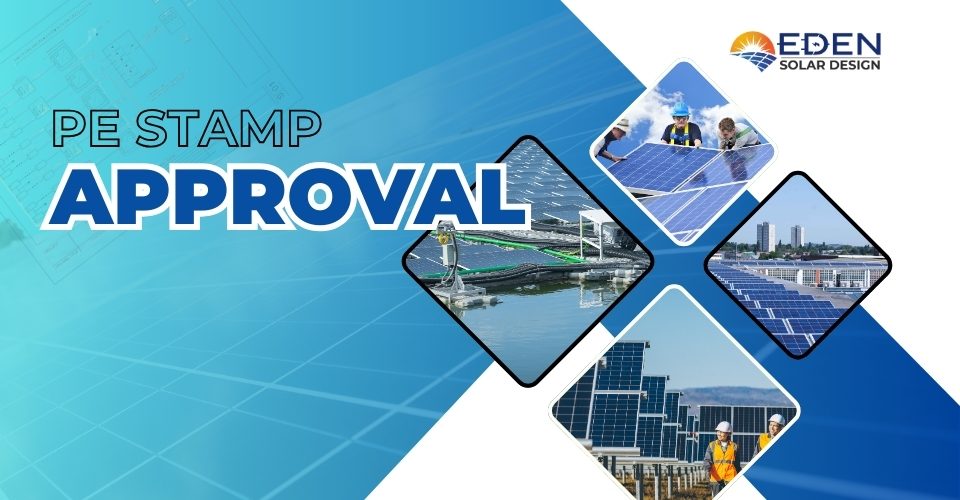Introduction: Why PE Stamps Matter in Solar Design
As solar adoption continues to grow across the United States, the need for code-compliant and structurally sound installations is more important than ever. One of the critical components in the permitting and design process for solar projects is the Professional Engineer (PE) stamp.
Whether you’re an EPC, solar installer, or developer, understanding when and why PE stamps are required — and how to obtain them efficiently — can save you costly delays, failed inspections, and rework. In this blog, we break down everything you need to know about solar PE stamp requirements across the U.S.
What Is a PE Stamp?
A Professional Engineer (PE) stamp is a seal provided by a licensed engineer that certifies a set of drawings or documents as being compliant with applicable building, electrical, or structural codes. It ensures that the work has been reviewed and approved by a qualified professional, and that it adheres to safety and engineering standards.
In the solar industry, PE stamps are commonly required for:
Structural design of solar racking or mounting systems
Electrical design for interconnection and system safety
Load calculations, wind/snow impact assessments
Ground mount and rooftop project validations
When Are PE Stamps Required in Solar Projects?
PE stamp requirements vary by state, AHJ (Authority Having Jurisdiction), project type, and system size. However, here are common scenarios where they are generally required:
1. Structural PE Stamp
Required when:
Rooftop system exceeds 10 kW
Custom or non-standard racking is used
There are modifications to roof structure
System is located in areas with high wind or snow loads
Mounting is on carports, canopies, or custom structures
2. Electrical PE Stamp
Required when:
System exceeds a certain capacity (e.g., >50 kW in some states)
System uses batteries or complex interconnections
Commercial or utility-scale projects
Required explicitly by the AHJ or utility
3. Both Structural & Electrical Stamps
In large commercial, industrial, or utility-scale projects
When the AHJ mandates stamped plan sets for complete review
Pro Tip: Always check the local AHJ website or consult a PE-backed design team like Eden Solar Design before submission.
PE Stamp Requirements by State (Overview)
Each U.S. state has its own engineering licensure board and requirements. Here’s a quick overview:
California: Structural PE often required for >10 kW rooftop. Electrical PE for >50 kW.
Texas: PE required for most commercial systems. Structural review mandatory in hurricane zones.
New York: Electrical and structural PE often required for large-scale systems.
Florida: Strict wind load and structural review requirements. PE mandatory for any elevated mounting.
Arizona/Nevada: Often lenient but AHJs may still require PE depending on system type.
Eden Solar Design works with licensed engineers in all 50 states, so you’re always covered no matter the project location.
How to Get a PE Stamp for Your Solar Design
There are two main ways to obtain PE stamps:
1. Work With a Design Partner Who Offers PE Services
The fastest and most reliable method is to work with a solar design company like Eden Solar Design. Our engineers:
Review your layout, calculations, and BOM
Perform structural and/or electrical assessments
Apply the required stamps on finalized drawings
2. Hire a Local Independent PE
This option may be more time-consuming and expensive. Independent engineers often have limited availability and may not be familiar with your project or solar-specific standards.
What’s Included in a PE Stamped Plan Set?
A complete PE stamped plan set typically includes:
Cover page with project details
Site layout with panel placements
Structural layout with racking/mounting specs
Electrical single-line diagram (SLD)
Wire/conduit sizing
Load calculations (wind/snow/structural)
Compliance notes and code references
PE signature and state seal
Common Issues with PE Stamp Submissions (And How to Avoid Them)
Incorrect structural calculations
Outdated NEC references
Improper wire sizing or breaker specs
No compliance with wind/snow loads
Using generic templates that don’t meet AHJ-specific needs
Solution: Use a verified design provider with multi-state PE support and AHJ experience.
How Eden Solar Design Simplifies the PE Stamp Process
✅ In-house access to structural and electrical PEs
✅ State-specific compliance and code knowledge
✅ Fast turnaround times (typically 1–3 business days)
✅ Combined Permit + PE packages available
✅ Experience across 1,000+ stamped projects
Whether you need just the stamp or full permit drawings with PE review, we offer scalable, reliable services to fit your workflow.
Conclusion: Stay Compliant. Stay On Schedule.
PE stamps are not just a formality — they’re a vital part of safe, compliant, and approval-ready solar design. From meeting building codes to satisfying utilities and inspectors, PE stamping ensures your designs hold up to scrutiny.
By working with a trusted partner like Eden Solar Design, you eliminate the guesswork and delays — and deliver faster, stronger, and smarter solar projects.






